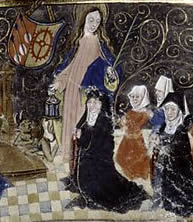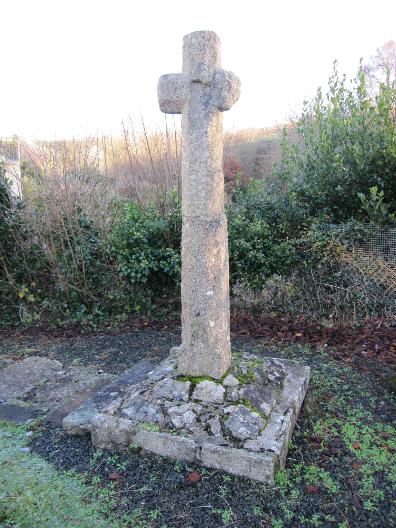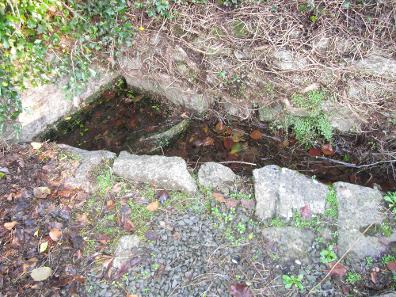
Our Lady's Well. 'In Ladwell orchard, near the ancient chapel of St Lawrence, now the Grammar School, and hard by the railway station, rises a copious spring of water which, until recently, formed a large pool. It is now covered and drained off underground. The overflow is still called Ladwell Brook, and unites with the Yeo or Ashburn stream, a short distance below the town. The spring in the orchard was formerly known as Our Lady's Well, now contracted into Ladwell. By the pool once stood a granite cross; the worked hexagonal base is now converted into a pump trough in a court in St Lawrence Lane. No tradition remains of any particular virtue attributed to the well, or of any superstitious observance connected with it.'
P F S A[mery], Report and Transactions of the Devonshire Association, vol 26, 1894, p82
See also Amery's The Recollections of Master Prideaux, under People and Properties, for legends about Lady-well - but I can find no other reference to them.
The following comes from notes made by Mr. and Mrs Hatch circa 1990.
'No
14 St Lawrence Lane had a granite (?) cross in the back yard, thought
likely to have come from Ladwell (Ladywell) Place off Whistley Hill.
(There was a cobbled area near the well, the cross missing).
Unfortunately the cross was broken up and used to fill a well at 14 St
Lawrence Lane by a previous owner, Mr Alfonso Turner.'
Many thanks to Jeremy Hatch for the above document.
William Crossing, Devon and Cornwall Notes and Queries, 1903, London, p477
*******
P F S A[mery], Report and Transactions of the Devonshire Association, vol 26, 1894, p82
* According to http://www.catholic.org and other sources, St Lucy is the patron saint of the blind. St Gudula is known for a divinely lit lantern (when the Devil blew out her candle to divert her from her path), so there is the idea of darkness being dispelled.

My own photographs circa 2013

In the lane, and quite close to the wall of the garden in front of the farm house, is a small mounting-block, the topof which is formed by a portion
William Crossing, Devon and Cornwall Notes and Queries, 1903, London, p478
F H Starkey points out that some people claim that the well is that of St Gulwall, a 6th century Celtic holy man.
Dartmoor Crosses, F H Starkey, Cornwall 1983, p114
In 1933 the cross from St Gudula's well was retrieved from where it had lain 'for several generations' and was re-erected by unemployed men. There were plans to restore the well if there were sufficient funds.
Western Times 10 March 1933 p13 col1
Background to Gulwell:
The Historical Gazetteer of England's Place Names gives the following references for Gulwell:
Goltawill in 1325 (Assize rolls)
and Goolewill in 1571 (Subsidy rolls)
When planning permission was sought in connection with land next to Pear Tree Cross the Dartmoor National Park made a report on the area. They noted that the medieval farm of Gulwell, with 15th century origins, had been situated there, and a number of medieval and later pottery finds had been recovered.
Dartmoor National Park 13 December 2013 http://www.dartmoor.gov.uk/__data/assets/pdf_file/0004/394951/20131206-DM-Reports-Part-1.pdf - Accessed 29-4-2016
John Perry of Gulwell married Ann Michelmore at Staverton 25 March 1768
http://www.mitchelmore.info/rawdata/uk/vitals/parishes/marriages1.htm
1887 [Gulwell Farm] 'is still in existence behind the modern residence of the Perry family. It is a remarkably good example of a yeoman's house of the olden times, and portions of it date apparently from the fifteenth century. It is built partly of Devonshire 'cob' and the whole of the interior woodwork is of oak. There is a good Tudor window in one of the rooms, and several square-headed Late Perpendicular doorways still remain. Some of the woodwork bears traces of elaborate carving, and upon the interior of one of the partitions there are still signs of chromatic decoration of an unusual character, remains of six figures in all, and they appear to have been painted on leather, and fastened afterwards there to the panels on which they occur...I was able to make out the semblance of a man in armour holding a sword; another with red and gold crown, and a winged figure of Justice, with scales depending from the neck.'
Charles Worthy, Devonshire Parishes, vol1, London 1887, p73ff
*******
Mentions of the Market Cross:
January 1747, feoffment, Weekes to Hill. Dwelling house near the Market Cross.
Ref 48/14/70/2 Devon Heritage Centre, https://devon-cat.swheritage.org.uk/records/48/14/70/2 - accessed 21-09-2020
October 1763, Lease and release, Weekes to Marsh. Dwelling house near the Market Cross.
Ref 48/14/70/3a-b Devon Heritage Centre, https://devon-cat.swheritage.org.uk/records/48/14/70/3a-b -
accessed 21-09-2020
July 1764 Release of equity of redemption, Weekes to Dunning, messuage near the Market Cross
Ref 48/14/70/6 Devon Heritage Centre https://devon-cat.swheritage.org.uk/records/48/14/70/6 - accessed 21-09-2020
A marriage settlement in 1826 (between Monday and Bawden) concerns a house near the market cross.
Ref 924B/F/2/20, Devon Heritage Centre http://devon-cat.swheritage.org.uk/records/924B/F/2/20
July 1847 Lease, Cranstoun to Michelmore. House near the Market Cross
Ref 48/14/70/11 Devon Heritage Centre https://devon-cat.swheritage.org.uk/records/48/14/70/11 - accessed 21-09-2020